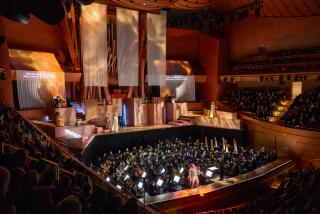Lang’s Silent Epic ‘Die Nibelungen’ at LACMA
- Share via
Fritz Lang’s newly restored two-part, 4 hours-and-48-minute “Die Nibelungen” (1924), which had its premiere revival last Saturday at the San Francisco Film Festival, screens tonight and Saturday at the Los Angeles County Museum of Art’s Bing Theater, with organist Dennis James performing his dynamic adaptation of Gottfried Huppertz’s original, glorious thunder-and-lightning score. “Siegfried’s Death” screens at 7, and after a 25-minute intermission, “Kriemhild’s Revenge” screens at 9:45 p.m.
Adapted by Lang’s then-wife Thea von Harbou from “Das Nibelungenlied,” the epic saga written by an anonymous Austrian poet around 1200 and from other Norse sagas, “Die Nibelungen” is a sweeping, monumental work of the most intense visual power. It represents the silent cinema in full command of its unique resources, revealing Lang as a major innovator in his use of the medium to express the psychology and inner life of his people. Backed by producer Erich Pommer, Lang had a raft of cinematographers, art directors, costume designers and special-effects technicians to enable him to create a highly stylized yet deeply evocative masterpiece.
“Die Nibelungen” deals with the most primary emotions--passion, betrayal and revenge--colliding with chivalric codes and in the process consuming an array of regal personages. It involves great battles and unfolds amid settings of the utmost grandeur. Even though there are not many incidents, each one has cosmic significance. “Die Nibelungen” is human nature in its duality of good and evil writ large.
Part I tells of the emergence of Siegfried (Paul Richter), the handsome, blond son of King Siegmund, who slays a dragon, bathing in its blood to render him apparently invulnerable, then captures the treasure of the Nibelungs and courts Kriemhild (Margarete Schon), the blond and beautiful sister to King Gunther (Theodor Loos) of the Burgundians. This seemingly perfect match, however, stirs the resentments of both Gunther’s suspicious half-brother, the warrior Hagen Tronje (Hans Adelbert von Schlettow) and the warrior queen of Iceland, Brunhild (Hanna Ralph) whom Gunther wishes to wed but who is in love with Siegfried herself.
One sequence after another unfolds in stately, measured fashion in settings of stark splendor. Surely the most bizarre image of either part of the film is that of the vast, round Nibelungen treasure table supported by a ring of chained dwarfs. As in most every silent film, there are those moments that draw unintended laughter--indeed, Lang himself considered his “Metropolis” hopelessly corny until his last years. But when the naive Kriemhild, realizing how cruelly she has been betrayed, gazes at the corpse of her beloved--and equally naive--Siegfried, her grief is so overpowering that it still can hold an audience in pin-drop silence.
About 40 minutes have been restored to “Die Nibelungen” by Munich Film Archive director Enno Patalas over a 12-year period, from prints found in the Soviet Union, Austria and England. Most of the restoration is from the second part, which tells of Kriemhild’s calculated marriage to the grotesque yet poignant Etzel--or Attila--King of the Huns (the remarkable character actor Rudolf Klein-Rogge, a frequent Lang star--and Von Harbou’s ex-husband). The ultimate folly of revenge, which brings down one and all in an orgy of battle and destruction, takes place on an appropriately epic scale. (If Part II seems a bit protracted and wearying, remember that the two parts were intended to be shown on separate evenings.) According to Patalas, only about 5 or 10 minutes remain missing from “Kriemhild’s Revenge” and may well have been deleted early in the film’s release.
Presented with the cooperation of the Goethe Institute, the restored “Die Nibelungen” is an event, and one to be cherished by all lovers of silent films--and one not likely to be repeated in the near future. Information: (213) 857-6010.
More to Read
Only good movies
Get the Indie Focus newsletter, Mark Olsen's weekly guide to the world of cinema.
You may occasionally receive promotional content from the Los Angeles Times.









